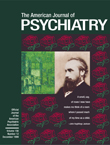Dimensional Approach to Delusions: Comparison Across Types and Diagnoses
Abstract
OBJECTIVE: A dimensional approach to the characterization of delusions was used to examine the use of non-content-related descriptors of delusions in revealing differences across diagnostic categories and delusion types. METHOD: Interviews with 1,136 acutely hospitalized psychiatric patients identified subjects as definitely or possibly delusional on the basis of screening questions derived from the Diagnostic Interview Schedule. Subjects with delusions were given the MacArthur-Maudsley Delusions Assessment Schedule, which generates scores on six dimensions of delusions. Delusions were classified by type, and diagnoses were assigned by using the DSM-III-R checklist. RESULTS: A total of 328 subjects (29%) were rated as definitely or possibly delusional. Their ratings on dimensions of the MacArthur-Maudsley Delusions Assessment Schedule were significantly but modestly intercorrelated. Subjects with schizophrenia generally had more intense delusions than those in other diagnostic categories. Grandiose and religious delusions were held with the greatest conviction, whereas persecutory delusions were marked by strong negative affect and a propensity to act. Factor analysis of the dimensions revealed a consistent two-factor solution—“intensity and scope” and “affect and action”—regardless of the diagnosis or delusion type. CONCLUSIONS: The stability of the dimensional structure of delusions across diagnoses and delusion types suggests that even seemingly diverse delusions are more like than unlike each other; this is consistent with common etiologic mechanisms. The utility of a dimensional approach is indicated, in addition, by the ability to characterize delusions of different types and diagnoses so as to highlight therapeutic and other implications.



